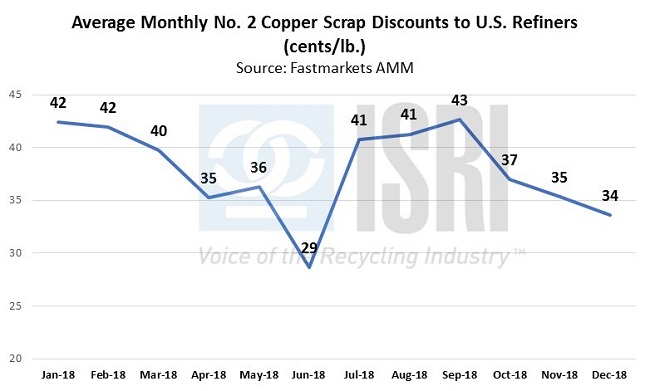Ferrous – The Wall Street Journal reported last week that as of December 17th, “the Commerce Department… granted about 75% of the 19,000 requests it processed to exclude products from tariffs on foreign steel that took effect in March…
Exclusions issued so far cover 3.8 million tons of steel, or about 16% of the finished foreign steel entering the U.S. through 11 months of 2018.”
According to the American Iron and Steel Institute, “In the week ending on December 29, 2018, domestic raw steel production was 1,899,000 net tons while the capability utilization rate was 81.0 percent…The current week production represents a 13.3 percent increase from the same period in the previous year. Production for the week ending December 29, 2018 is up 1.6 percent from the previous week ending December 22, 2018 when production was 1,870,000 net tons and the rate of capability utilization was 79.8 percent. Adjusted year-to-date production through December 29, 2018 was 95,063,000 net tons, at a capability utilization rate of 78.3 percent. That is up 6.2 percent from the 89,483,000 net tons during the same period last year, when the capability utilization rate was 74.0 percent.”
Ferrous scrap prices advanced over the course of 2018, with No. 1 heavy melt averaging $333.50 per ton. U.S. ferrous scrap exports were up about 20 percent in 2018 compared with 2017 thanks to improved overseas demand for obsolete ferrous scrap. On the domestic front, new durable goods orders hovered around $243 billion per month and were on a similar track with ferrous scrap prices. While purchasing has remained consistent, capacity utilization and personal expenditures on durable goods steadily increased over the course of the year. U.S. automobile sales were similar in 2017 and 2018 in terms of the number of units sold, but the composition of those sales shifted 5 percent from passenger vehicles to light trucks or larger vehicles.
Nonferrous – Our friends at the International Copper Study Group report that world secondary refined copper production (from scrap) increased 12% during the first 9 months of 2018 to more than 3.4 million metric tons. COMEX copper prices rebounded on Friday but as we report in our 2019 Market Forecast to appear in the Jan/Feb edition of Scrap magazine, “China’s restrictions on copper and copper alloy scrap imports continue to reshape the global market, a process that’s likely to continue well into 2019. According to trade figures from the U.S. Commerce Department, U.S. copper and copper alloy scrap shipments to mainland China were down 55 percent by volume during the first 10 months of 2018, although larger shipments to Malaysia, South Korea, Japan, India, Thailand, and other countries helped offset the reduction in Chinese demand. China’s increased demand for higher-quality packages of No. 1 (Bare Bright) and No. 2 copper may contribute to tighter market conditions for those commodities, while lower-quality scrap commodities may see more balanced market conditions.” Meanwhile, Fastmarkets AMM reports that spreads on No. 2 copper scrap in the U.S. tightened significantly in the fourth quarter of 2018:

Paper and Plastic – The Chinese government has granted RCP import licenses of 5.47 million metric tons to 58 companies in two rounds of releases. The second round of licenses appear to be an expansion focused on large packaging producers and believed to be an anticipatory move to avoid problems in their domestic RCP market. This is a good sign that the government is aware of the market effects of a heavy-handed approach to their import policy restrictions on scrap recyclables. Does it mean that the older paradigm of Chinese consumption of recovered paper is on the horizon? That’s still highly doubtful.
Dr. Paper of BMO Capital Markets has many of the major packaging producers rated at or above expected market performance. The indication of market optimism for packaging producers going into 2019 may be helpful as the overall performance of these stocks have been down virtually across the board at this time a year ago.
Bans on single-use plastics are becoming a growing trend as New York, NY and Washington, DC implement bans on expanded polystyrene (EPS) food service packaging and straws. The European Parliament approved a ban on single-use plastics by 2021 which include sticks for cotton swabs, cutlery, and straws. The European legislation goes further to restrict product design, collection systems for beverage bottles, and implementing consumption reduction targets. These initiatives seem much more driven by the alarmed reaction to marine litter which unfortunately may push onerous restrictions onto recyclers despite the viable solutions requiring smartly regulated international trade.
Despite calls from OPEC to reduce production and buoy up prices, production cutbacks softened significantly during the second half of 2018. Saudi Arabia, UAE, Kuwait, and Iraq are some of OPEC’s largest producers and least compliant to the terms of the production cutback. Their production cutback noncompliance, however, pales in comparison to virtual disregard that the non-OPEC countries, who were party to the production cutback agreement, have continued or increased their production pace. With U.S. production of fossil fuels (particularly natural gas) rapidly increasing, the glut in supply is likely to continue to suppress pricing into 2019. That will make the natural gas feedstock for virgin plastic resin looking rather cheap.
For more information, please contact ReMA Research Analyst Bernie Lee.
Back to Main